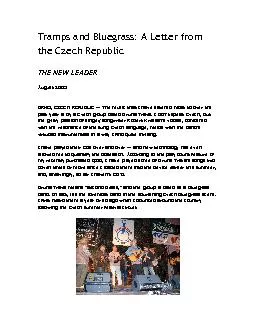/


they performed two classic instrumentals Cripple Creek and Foggy Mountain Breakdown The little Czech Republic showed the whole world that they have the highest concentration of bluegrass ban ID: 197678
Download Pdf The PPT/PDF document "THE NEW LEADER August 2005 BRNO, CZEC..." is the property of its rightful owner. Permission is granted to download and print the materials on this web site for personal, non-commercial use only, and to display it on your personal computer provided you do not modify the materials and that you retain all copyright notices contained in the materials. By downloading content from our website, you accept the terms of this agreement.
THE NEW LEADER August 2005 BRNO, CZECH REPUBLIC -- The music that I have listened most to over the past year is by a Czech group called Druha Trava. I don't speak Czech, but the gritty passion of singer/songwriter Robert Krestan's vocals, combined with the resonance of the sung Czech language, melds with the band's virtuoso instrumentals in a way I find quite thrilling. I have played their CDs over and over -- and new technology has even allowed me to quantify the obsession. According to the play count feature of my recently purchased Ipod, I have played some of Druha Trava's songs two they performed two classic instrumentals -- "Cripple Creek" and "Foggy Mountain Breakdown". "The little Czech Republic showed the whole world that they have the highest concentration of bluegrass bands on earth," said Lilly Pavlak, a Czech-born bluegrass fan who for more than 30 years has been instrumental in promoting the music in the Czech Republic and abroad. Lilly, who is in her early 60s, left Czechoslovakia after the Sovietled invasion in 1968 and has lived in Switzerland more or less since then. For years, starting in 1975, she made tapes of bluegrass music from American LPs and sent them to her friends in Czechoslovakia. At the time, it was difficult, if not impossible, to obtain original American recordings. Lilly's friends copied and recopied her tapes and passed them around from player to player, like secret, even subversive, messages from across the global divide. Indeed, during the darkest years of communist rule, singing American-style music often became an oblique way of expressing protest against the regime. Lilly was not able to return to Czechoslovakia until 1987, but when she did, she found poignant evidence of how widespread her influence had become. During that homecoming trip, she said, "I hitch-hiked toward the Oslavka River, and the people in the car that stopped for me were listening to a bluegrass tape. It was very familiar to me. I knew exactly what the next song would be -- once, long ago, I had put this tape together for a Czech Lilly's involvement with the music began, as it did for many other Czech fans and musicians, in the so count the music. I could have gone on singing for three days without stopping." In 1964, Lilly was present at a seminal performance that electrified tramp music fans and changed the face of the Czech acoustic music scene. It was a concert by Pete Seeger, the second of two concerts that the American folk legend performed in Czechoslovakia following a tour of the Soviet Union. "I had never seen a living American before, and at school we learned the worst things about the 'American imperialists,'" Lilly has recalled. "Some people even believed that they ate little children!" What's more, she said, "Pete sang a lot of songs we knew from tramp music, and so I realized that they must be American originals, not just tramp songs. That was the defining moment not just for me, but for the entire bluegrass movement that followed." What particularly struck her and other fans were the appearance and sound of Seeger's long-necked, five-string banjo. According to legend, Seeger's performances in Prague and Brno marked the first time after World War II that a five-string banjo was seen and heard to be played live in Czechoslovakia. Lilly and other fans have recalled to me how they would listen to "hillbilly music" on the "forbidden but beloved" American Armed Forces Radio, beamed from West Germany across the Iron Curtain, and try to figure out what instrument made the distinctive, ringing sound that was so Cermak also founded one of Czechoslovakia's first American-style country and bluegrass groups, the Greenhorns. The Greenhorns became extremely